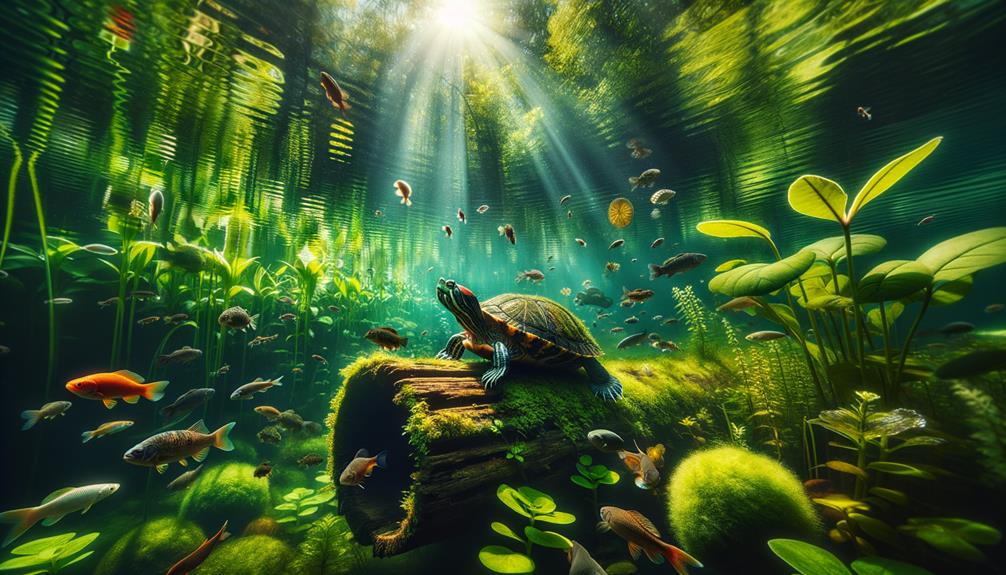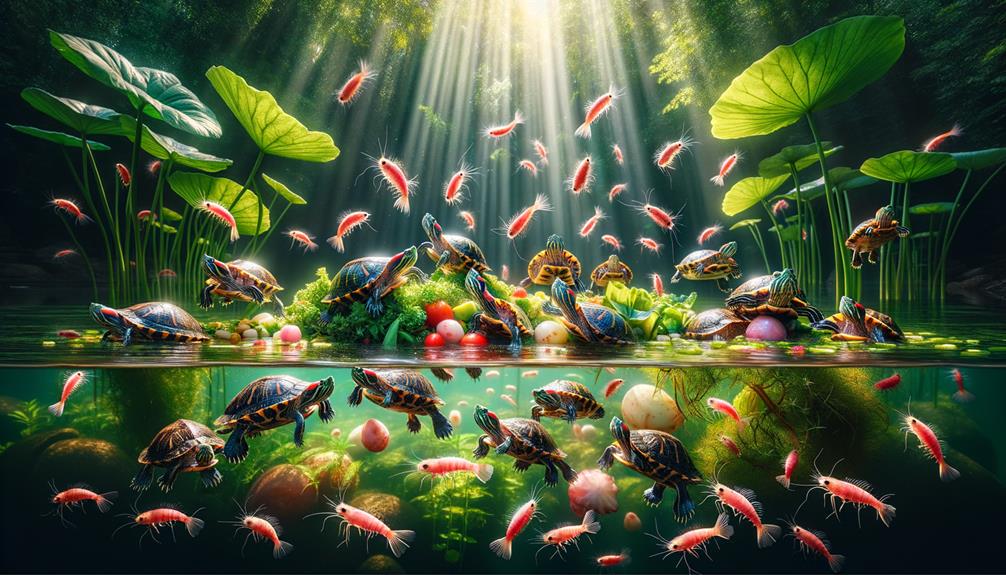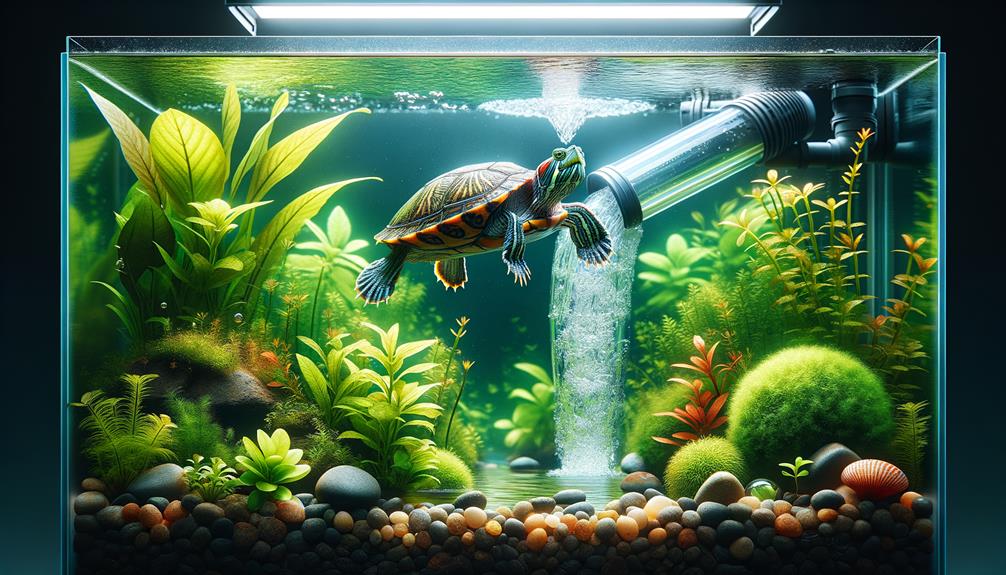Red-Eared Sliders are a popular pet choice due to their distinctive dark brown shell and bright red stripe behind each eye. Native to the southeastern United States, they thrive in warm freshwater habitats. These turtles are semi-aquatic and bask frequently, requiring a balance of commercial food, fresh vegetables, and protein supplements in their omnivorous diet. Though enjoyable to keep, they demand meticulous care, particularly in maintaining water quality to prevent diseases like Salmonella. Their invasive potential has led to legal restrictions. Understanding these facets is crucial for responsible ownership.
Key Takeaways
Red-eared sliders are recognizable by the distinctive red stripe behind each eye. They're highly adaptable, thriving in both water and on land environments. Their omnivorous diet makes them easy to feed with commercial food, vegetables, and protein supplements. They exhibit interesting behaviors like basking on logs and quickly retreating to water when sensing danger. Despite their popularity, they have invasive status and can pose ecological and public health risks.
Description
Red-eared sliders are medium-sized freshwater turtles characterized by their dark brown carapace and distinctive red stripe behind each eye. Notably, females are larger than males, a trait crucial for understanding their biology. Females also have a flatter plastron compared to the more concave plastron of males. This distinction extends to their tails, with males often having thicker and longer tails, a feature vital for species identification.
The shell of red-eared slider turtles is divided into three distinct types of scutes: vertebral, pleural, and marginal. As they mature, the coloration of these scutes changes over time, with young sliders displaying vibrant hues that gradually darken with age. Curiously, older males can develop a melanistic coloration, making them appear almost solid black.
In their youth, red-eared sliders are indistinguishable by sex, but undershell markings aid in their identification as they mature. Native to the southern United States, red-eared sliders have been found in various other regions due to their popularity in the pet trade. Understanding these physical characteristics is crucial in identifying and studying this fascinating species of turtles.
Habitat and Distribution

When it comes to understanding the habitat and distribution of red-eared sliders, it's essential to look at their native range, which primarily covers the southeastern United States, particularly the Mississippi River Valley and Gulf of Mexico regions. These turtles thrive in calm, warm freshwater environments, such as ponds, lakes, rivers, and marshes, where they often bask on logs or other objects protruding from the water. However, their introduction to other parts of the world, including the western United States, has led to significant ecological concerns due to their impact on native species and the environment.
Native Geographic Range
Native Geographic Range
Red-eared sliders are mainly found in the southeastern United States, where they inhabit warm freshwater environments such as creeks, rivers, ponds, or shallow lakes. Their native range spans from eastern Texas to the Florida panhandle, and extends northward to southeastern Illinois, Indiana, and Ohio. These turtles thrive in calm waters, often basking on logs or other objects protruding from the water.
In their native range, sliders coexist with other native species, contributing to local biodiversity. Historically, native turtles were harvested for food, but red-eared sliders have proven resilient. However, their introduction to non-native regions has transformed them into an invasive species. They have been transported to places like Europe, Asia, Africa, and the western United States, where they outcompete and displace local turtle populations, disrupting ecosystems. Understanding their indigenous habitat is crucial for addressing their impact as an invasive species elsewhere, highlighting the delicate balance within their native environments.
Optimal Living Conditions
Here's how adaptable red-eared sliders thrive in diverse aquatic environments. Native to the southeastern United States, they prefer calm, warm freshwater habitats like ponds, lakes, rivers, and marshes. These habitats provide essential basking sites, including fallen logs and rocks, which are vital for thermoregulation. Between March and October, the turtles actively bask to maintain their body temperature. As temperatures fall, they become less active, often retreating to the water's depths to hibernate.
As semi-aquatic creatures, red-eared sliders are well-suited to living both in water and on dry land. Their shell adaptations, including the bottom plastron and top carapace, make them capable swimmers. Additionally, their climbing ability allows them to access various basking sites and expand their range. They eat a balanced diet of plants and small aquatic animals, supporting their growth and development.
Red-eared sliders reach sexual maturity around 5-7 years of age, depending on environmental conditions and food availability. Their adaptability and resilience, combined with human introductions, have allowed them to colonize a variety of aquatic environments globally, sometimes becoming invasive.
Diet and Feeding

Red-eared sliders require a well-rounded diet that mirrors their omnivorous nature, consisting of a mix of fresh vegetables, protein-rich supplements, and commercial turtle food. Young turtles, in particular, need a precise diet to ensure proper growth and health. Their ideal diet typically includes 25% commercial turtle food, 60% fresh vegetables, and 15% protein-rich supplements like worms, crickets, and small fish. This balanced approach helps them achieve the ideal carapace length and overall development.
Feeding these turtles plays a vital role in their well-being. A structured feeding regimen is particularly beneficial for household pets like red-eared sliders. Let's examine the nutritional specifics:
- Commercial Turtle Food: Provides essential nutrients in a controlled manner.
- Fresh Vegetables: Leafy greens and aquatic plants supply necessary vitamins and minerals.
- Protein-Rich Supplements: Insects and small fish offer indispensable proteins for muscle and tissue growth.
- Calcium and Vitamin Supplements: Crucial for maintaining shell and bone health.
Female and male turtles may have slightly varied dietary needs, influenced by incubation temperature, which affects their growth rates. By adhering to these dietary guidelines, we can ensure our red-eared sliders remain healthy and vibrant.
Behavior

Understanding the behavior of red-eared sliders is vital for their well-being in captivity. These turtles thrive in both water and on land, often basking on logs or rocks near water surfaces to regulate their body temperature. They alternate between these basking sites and cooler aquatic environments to maintain a stable body temperature.
Red-eared sliders exhibit intriguing social behaviors. While they often bask in groups, they are also territorial and will defend their chosen basking spots from other sliders. This territoriality is crucial to consider when housing multiple turtles together, as it can lead to conflicts. When they sense danger, they quickly slide off basking sites into the water, a behavior essential for their survival in the wild.
During the winter months, red-eared sliders enter a state of dormancy, similar to hibernation. They become inactive, resting at the bottom of ponds or shallow lakes. This period of inactivity conserves energy and helps them survive colder temperatures. By grasping these behavioral patterns, we can provide environments that cater to both their social and physiological needs.
Health and Hygiene

Maintaining the health and hygiene of red-eared sliders requires meticulous attention to their environment, particularly with respect to water quality and cleanliness. This focus is vital to mitigate the risk of Salmonella, a bacteria these turtles can carry, potentially infecting owners, especially those who are immunocompromised. To guarantee ideal conditions, I follow several critical practices:
- Regular Tank Cleaning: I thoroughly clean the entire tank every month, ensuring all surfaces are scrubbed and disinfected.
- Water Quality Maintenance: I change at least 25% of the tank water weekly to keep the environment fresh and healthy.
- Effective Filtration: A high-quality filter is necessary to maintain clear water and reduce harmful waste buildup.
- Dedicated Feeding Location: Feeding my turtle in a separate area minimizes waste in the main tank, enhancing water quality.
Hand-washing is an indispensable part of my routine after handling my red-eared slider, reducing the risk of Salmonella transmission. These steps are not just about keeping the turtle healthy; they also protect my well-being and that of anyone who interacts with my pet. By dedicating myself to these practices, I ensure a harmonious and safe living environment for both my red-eared slider and myself.
Legal and Invasive Status

When considering the legal and invasive status of red-eared sliders, it's crucial to address regulations and ownership limits first. Many regions have restricted these turtles due to their potential to outcompete native species, which has led to the development of stringent legal frameworks. The environmental impact concerns highlight the need for responsible ownership and proper disposal to mitigate ecological harm.
Regulations and Ownership Limits
The sale and ownership of red-eared sliders are heavily regulated due to their status as an invasive species and the health risks they pose, with specific restrictions varying by region. As a responsible pet owner, it's crucial to understand and adhere to local regulations to safeguard local ecosystems and prevent Salmonella outbreaks.
In the United States, a pivotal regulation was enacted in 1975, banning the sale of red-eared sliders under 4 inches in length, primarily to mitigate Salmonella risks. Although native to the southeastern United States, they have become a priority invasive species elsewhere, often outcompeting native turtles for resources. As a result, several countries have implemented bans on their importation and ownership.
To emphasize the significance of these regulations, consider the following key points:
- Public Health Risk: Red-eared sliders can transmit Salmonella, posing a significant health risk.
- Ecological Threat: They are invasive species that threaten native turtle populations.
- Legal Requirements: Local regulations vary, making it essential to stay informed.
- Conservation Efforts: Monitoring and trapping programs, especially in states like Oregon, aim to curb their spread.
Adhering to these regulations isn't just about compliance; it's about contributing to a broader effort to protect public health and ecological balance. By doing so, we can ensure a safer and more sustainable environment for both humans and animals.
Environmental Impact Concerns
Understanding the legal and invasive status of red-eared sliders highlights the significant environmental impact and the urgent need for strict regulations. As one of the world's most invasive species, red-eared sliders outcompete native wildlife, leading to severe ecosystem disruption. Their ability to dominate habitats results in intense habitat competition, particularly with indigenous turtles, ultimately threatening biodiversity.
Many countries have imposed an import ban and restrictions on keeping these turtles as pets. In the United States, for example, the sale of red-eared sliders under 4 inches has been banned since 1975. This measure aims to curb the pet trade and prevent their release into the wild. In addition to ecological concerns, red-eared sliders pose a public health risk by acting as asymptomatic carriers of Salmonella, especially endangering vulnerable populations like children and the elderly.
Efforts by organizations, such as the Tualatin Soil and Water Conservation District, are crucial in managing this issue. Through monitoring, trapping, and reporting, these initiatives help mitigate the environmental impact. It's clear that strict regulations and proactive measures are necessary to protect native ecosystems and maintain ecological balance.
Frequently Asked Questions
Why Are Red-Eared Sliders so Popular?
Red-eared sliders are extremely popular pets due to their low-maintenance care and affordability. With a long lifespan, they offer a sense of companionship, and their unique appearance fascinates pet enthusiasts seeking a long-term commitment.
Do Red-Eared Slider Turtles Make Good Pets?
I believe that with the right mindset, red-eared sliders can make wonderful pets. They do require a lot of care and attention, though. Since they can live for up to 20-30 years, you'll need to be prepared to make a long-term commitment to providing them with a suitable habitat and proper care.
Are Red-Eared Sliders Cuddly?
Red-eared sliders aren't typically considered cuddly pets. Their independent nature and protective shells make them less suitable for physical affection. They tend to prefer minimal handling and may withdraw or bite when picked up, highlighting the importance of providing them with enriched habitats.
What Is the Most Popular Turtle Breed?
The red-eared slider is the most popular turtle breed, and for good reason. Its vibrant coloration, manageable care, and long lifespan make it a sought-after pet. However, prospective owners should be prepared for its large adult size and specific habitat requirements.



